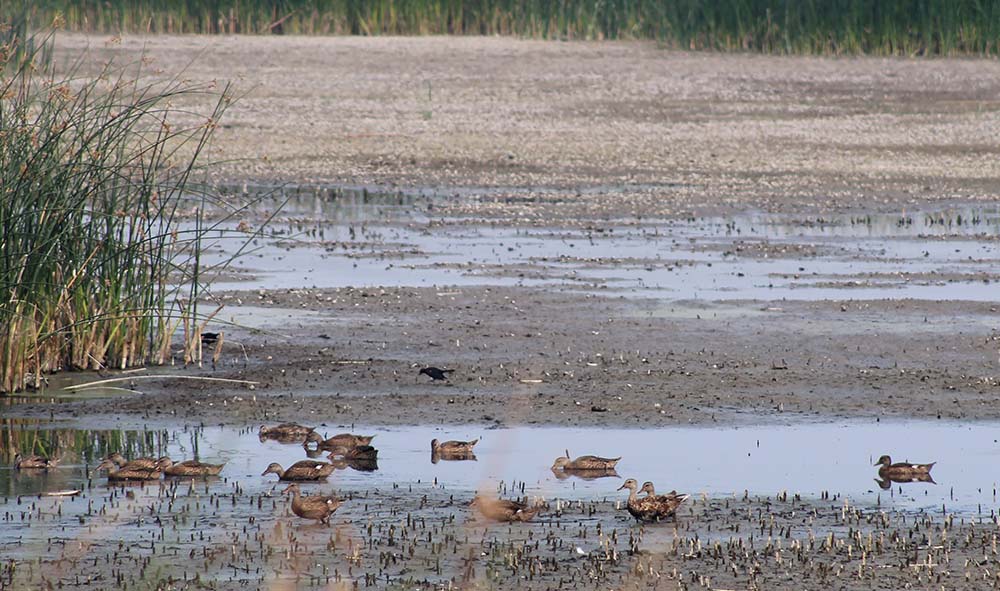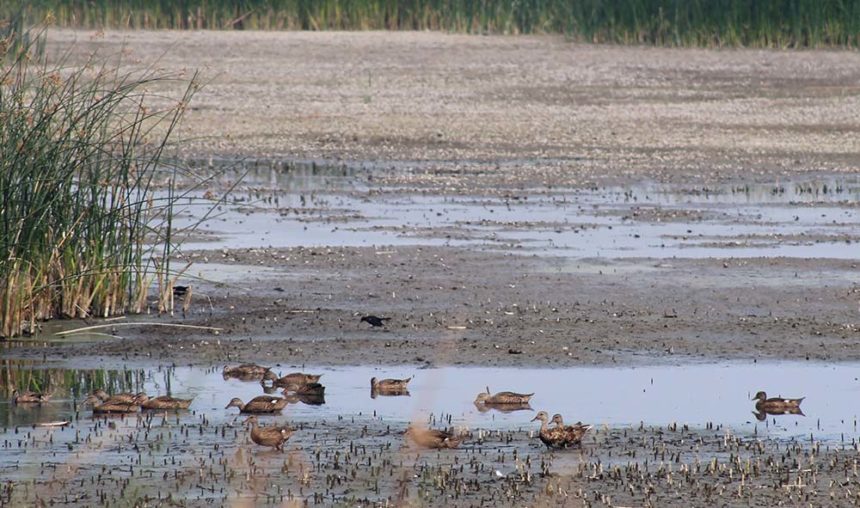
Mar 31, 2020
New settlement will restrict water available to the Lower Klamath NWR
A new settlement will reduce water available to the Lower Klamath National Wildlife Refuge. But it also may provide an opportunity to advocate for the refuge on future water decisions.
by JEFFREY VOLBERG, DIRECTOR OF WATER LAW AND POLICY
What’s new | Background | Yurok II | Settlement | Effects of the settlement

Flightless ducklings were left high and dry at the Lower Klamath National Wildlife Refuge in the summer of 2018 as wetlands drained - the result of a court injunction. PHOTO BY CAROLINE BRADY
A settlement reached late last week in Yurok Tribe v. Bureau of Reclamation will reduce the amount of water available to the Klamath Reclamation Project until at least Sept. 30, 2022.
This means the Lower Klamath National Wildlife Refuge will be less likely to receive surplus irrigation water in late summer and fall, as it did last fall, helping provide much-needed habitat to waterfowl migrating south for the winter.
Lower Klamath, when wet, provides critical habitat for waterfowl at key points in their life cycles throughout the year. The refuge is an important molting area for ducks, particularly California mallards, whose breeding populations are in sharp decline. Lack of molting areas in late summer and early fall can become a bottleneck for their population – because ducks are flightless when they molt, they are extremely vulnerable to predators. In addition, Lower Klamath is a key staging area for waterfowl migrating south for the winter.
This settlement will reduce water available to irrigators and the refuge by 40,000 acre-feet. When available water was reduced by 50,000 acre-feet in 2018, the refuge largely dried up and had the lowest bird counts on record.
Coupled with emerging drought, this settlement is not good news for the refuge.
Background | (Back to top)
In 2017, the Yurok Tribe of Del Norte and Humboldt counties sued the U.S. Bureau of Reclamation over the Bureau’s failure to conduct a new consultation with the National Marine Fisheries Service (NMFS) and the U.S. Fish & Wildlife Service (USFWS). The consultation is a requirement of the Endangered Species Act whenever the Bureau promulgates an operation plan for the Klamath Reclamation Project. The consultation results in biological opinions regarding the effects of the operation plan on listed species. The biological opinions are incorporated into an environmental assessment that informs and underpins the operation plan.
In the case of the Klamath Project, the re-consultation was two years overdue and the Yurok Tribe claimed that was having a detrimental effect on listed coho salmon, because there were insufficient flushing flows to scour the Klamath River of a particular parasite, C. Shasta, that infects and kills hundreds of salmon each year.
The Yuroks asked the federal judge in San Francisco for an injunction that would require the Bureau to sequester 50,000 acre feet of water in Upper Klamath Lake until the Bureau consulted with the fisheries agencies and received their biological opinions. The Bureau really had no defense, because it was undeniably late in consulting with the fisheries agencies. The Klamath Water Users Association (KWUA), which had intervened in the case as a defendant, cited damage to the Lower Klamath National Wildlife Refuge’s water supply as an unintended consequence of the injunction, but produced no evidence of that impact. The judge granted the injunction in the fall of 2017, but noted that the impact on the refuge’s water supply was unknown.
In the fall of 2018, the impact of the 2017 injunction became apparent. Because of the injunction, the Klamath Project fell short of the full allotment for farms, meaning that there was no surplus water available for the refuge. The refuge was dry throughout the fall of 2018, with the lowest bird numbers recorded since the beginning of the refuge.
On March 31, 2019, the Bureau adopted its operation plan for the Project, based on the newly completed biological opinions. The biological opinions alleviated the amount of water being held back for flushing flows by adopting a number based on actual conditions, rather than the arbitrary 50,000 acre feet required by the injunction. The number was based on calculations by a biologist who has been a major source of the science and calculations relied upon since the early 2000s.
In terms of rain and snowpack, 2019 was a very wet season. The irrigation season opened with 130 percent of normal precipitation. Under the biological opinions, however, the Project was only allotted 90 percent of its normal allotment. Because of wet and rainy conditions late into the spring, many farmers were late planting, and, with a mild summer following, irrigation demand was down. Toward the end of the summer it became apparent that there would be a considerable amount of unused water in the Project. KWUA and other irrigators agreed that the water should be delivered to the refuge.
The refuge was already in good shape and prepared to make best use of the water. Through October, the Project delivered approximately 35,000 acre feet to the refuge. Bird numbers rebounded.
Yurok v. Bureau of Reclamation II | (Back to top)
By midsummer 2019, it became apparent that the calculations on which the biological opinions were based were incorrect and the biological opinions required too little water to be retained for flushing flows. The flushing flows that were sent downriver in the spring actually increased the presence of C. Shasta. The tribe sued again, seeking another re-consultation to correct the errors. In the fall of 2019, they again requested an injunction to reinstate the 50,000 acre foot requirement for flushing flows.
KWUA again intervened as a defendant. The Bureau’s defense was that it had properly consulted with the fisheries agencies and that the Bureau and KWUA should not be held responsible for their calculation errors. California Waterfowl submitted an amicus brief describing the devastating impact of the 2017 injunction on the refuge.
The settlement | (Back to top)
In late March, the parties reached a settlement in the lawsuit. The settlement has the following elements:
- The tribe’s motion for an injunction will be set aside.
- The re-consultation must be completed by September 30, 2022.
- The Bureau will set aside 40,000 acre feet in an Environmental Water Account (EWA) for flushing flows until the biological opinions are completed in 2022.
- 23,000 acre feet will be taken from the Klamath Project allotment for irrigation.
- 17,000 acre feet will be held in Upper Klamath Lake.
- A 20,000 acre foot augmentation of the EWA that was adopted in 2018 will continue in effect.
- Releases of flushing flows for salmon will be coordinated with Pacificorp, which maintains a series of four hydroelectric dams in the Klamath River.
- The Bureau will continue to maintain required minimum elevations in Upper Klamath Lake in order to protect the listed shortnose suckers and Lost River suckers in the lake.
Effects of the settlement | (Back to top)
The settlement will reduce the amount of water available to the Project until at least September 30, 2022. This will mean that the refuge will be less likely to receive surplus water in late summer and fall. The refuge has completed a long-term water rights transfer from above Upper Klamath Lake, which should provide enough water between April and September to keep the refuge from entirely drying out.
For 2020, which is shaping up to be an extremely dry year for the Project, there is federal drought relief money available, which will allow local water agencies to buy water from farmers to supplement the refuge’s supply. The drought relief money is only available in 2020, unless Congress reappropriates it in subsequent years.
One benefit of the settlement is that the Bureau will have two years to complete its new operations plan. Originally, the re-consultation to correct the calculation errors was to be completed by March 31, 2020, which left no time to consider other changes. Under the extended deadline, it may be possible to advocate for the inclusion of the refuge’s needs in the biological opinions. In the past, the refuge’s water needs have never been considered or included in the biological opinions, even though the refuge is administered by the USFWS, which is one of the agencies preparing the biological opinions.
California Waterfowl is closely monitoring the refuge’s water supply and working in a number of forums to return the refuge to an adequate and reliable water supply. With an adequate water supply, the refuge can produce a large portion of the Central Valley’s resident mallards and other ducks.
Learn more about our efforts here.


